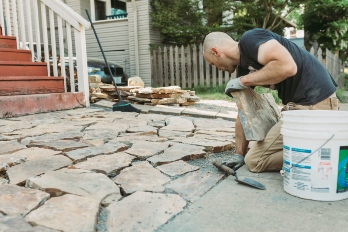Community land trust homeowners all seem to tell the same story. But it’s exciting every time you hear it.
It goes like this: Before they bought their home through a community land trust, they struggled with high rents and instability. After, they had a home they could afford, the stability that comes with that, and the freedom to live the lives they envisioned for themselves and their kids.
“It was such a dramatic change for us,” says Bob Robbins, looking back to when he and his family first moved into their home, in 1995.
They’d been living in a terrible apartment in Burlington, VT. As their two kids approached school age, he and his wife desperately wanted to find a better living situation. But rents were “incredibly high,” and on their income, they didn’t stand a chance in the conventional housing market. “We were frozen out,” he says.
Then they heard about their local nonprofit community land trust (CLT). The CLT worked with them until they found the right land trust home. They now owned a house, made affordable because the CLT leased them the land for almost nothing, basically forever.
“After all of the insecurity and the problems we had in the rental unit, all of a sudden, all that went away,” Robbins says. “We had stability and a very affordable mortgage. We were not only able to pay our bills but put away money for the kids’ college and some money towards our retirement.”
Almost 25 years later, the benefits are even more clear. “That whole period of life was so much richer,” he says, “because we had access to all those resources that we wouldn’t have had if we were paying high rents or scrimping and saving for a down payment for a conventional home.”
To bring you the details on how community land trusts work, plus the pros and cons, we called up expert Jason Webb. He’s been working with CLTs for 30 years, currently as a capacity building specialist for the Grounded Solutions Network.
You own the house, but the CLT owns the land
CLTs might be new to you, but they’ve been creating permanently affordable, community-controlled housing for a half century. The model is really taking off now, as communities look for ways to address the housing crisis. There are nonprofit CLTs in almost every state, says Webb, upwards of 300 nationwide.
Here’s how it works. The CLT acquires properties, either renovates or builds, and then sells the homes to low- and moderate-income buyers while retaining ownership of the land. Homeowners lease the land from the CLT, usually for a small monthly fee somewhere between $10 and $75. The typical “ground lease” lasts 99 years and is renewable. This is part of what makes CLT homes so affordable — you’re only buying the building.
The ground lease is the hardest thing for aspiring homeowners to get their heads around, says Webb. “One of the big things that I say to folks is, ‘But do you ever own your land?’ If I don’t pay my taxes, what happens to my property?”
The answer, just to be clear, is that your city or town can foreclose on your home to extract the taxes you owe. That’s right. In many states, you can spend 30 years paying off your home and then lose it because of a small unpaid property tax bill.
“I tell people not to allow non-ownership of land to be the only barrier,” Webb says. “A ground lease gives you full rights and full privileges to use the land for as long as you want. And it gives you the ability to pass on the property to your heirs.”
You still build equity, but usually not as much
When you buy a CLT home, part of the deal is that it will remain permanently affordable. You can’t sell it on the open market, where an absentee landlord or a developer might turn it into an expensive rental or flip it for a profit. Instead, the land trust will typically either buy the home back or help you find another low- to moderate-income buyer.
That doesn’t mean you won’t build any equity at all. You’ll pocket what you invested, plus an inflation factor established by the CLT.
“We don’t care about what’s happening in the market,” says Webb. “Let’s say the market increases by 35 percent, but our resale formula says only 15. That additional 20 percent gets wrapped into the property as a subsidy for the next owner.”
As prices continue to go up, land trust properties become more and more affordable in relation to the market.
“It’s a fine balance,” Webb says, “because you want to make sure you’re giving folks a fair return on the improvements they’re investing in. But at the same time, you want to make sure the property stays affordable.”
You won’t retire on a “fair return,” but it might enable you to buy your next home in the conventional market. In fact, some CLT programs are specifically designed as stepping-stones.
Another kind of wealth: community
The question is, what do you really want to get out of your home?
“Going into a community land trust, just by its nature, you’re going to have a very different relationship to your home than if you were out on the open market,” says Webb. “You’re not just becoming a homeowner.”
In some cases, your home might be part of a larger community revitalization effort. For example, a CLT might buy and renovate several vacant properties in a drug-ridden area, launching the neighborhood into an upward spiral that’s exciting to be a part of.
“If you want to become more involved in your community, I don’t think there is anything better than the CLT model,” says Webb.
The stability you need to live your life
Stability is a word you hear over and over again from CLT homeowners. As you may know all too well, when you don’t have it, it’s hard to get out of survival mode and really live.
CLT homeowner Rusty Diggs was a migrant agricultural worker when she gave birth to premature twins, one of whom ended up with a life-threatening hospital infection. Then she lost her Orcas Island, WA, apartment because the landlord’s daughter wanted to live there. She and her partner found a new place, but the rent was 70 percent of their income.
In 2005, a CLT home allowed her family to settle in their island community at a price they could afford. Today, her daughters are growing up secure and happy, and she’s able to do work she loves, educating teens about farming and sustainability.
“I was never expecting to be a homeowner,” she says. “It changed my life … Because of the fact that I had stability, I’ve been able to reach out and do more.”
Artist Carla Stanley is another Orcas Island resident whose life changed when she bought her CLT home. “Once I got the house, it was like the whole creative part of me kablooied,” she says, recalling the 2010 purchase. “If I would not have gotten a stable home, I probably wouldn’t have done the amount of artwork to supplement my income the way I’ve done now.”
Plus, you’re protected from market downturns
While you might not build as much equity with a CLT, you probably won’t lose your investment either. The price you pay for your home won’t be inflated to start with, so it won’t deflate if the housing market goes bust like it did in 2008. Put another way, the subsidy that’s built in acts as a buffer — you’re much less exposed to the market.
As Webb explains, if the market price on a home is $200,000, but the truly affordable price is $100,000, the CLT subsidizes $100,000. A market downturn probably isn’t going to eat all the way through that $100,000 buffer and into your own investment.
That’s compelling when you consider that more than 9 million families lost their homes to foreclosure or short sale between 2006 and 2012. Many still haven’t recovered either their investments or their pre-crash lives.
No CLT in the Grounded Solutions Network lost any homes to foreclosure as a result of the 2008 crisis, Webb says. In fact, CLT homeowners weren’t even underwater.
Predatory lending wasn’t a problem either, he says. “The way a community land trust is structured, there are built-in safeguards. We’re a safety net for homeowners, so they don’t fall into the same traps as folks in the traditional market.”
Yes, you can buy a CLT home with a traditional mortgage
CLTs aren’t quite commonplace yet, but Webb says it’s not hard to find a bank that will give you a mortgage loan for a CLT home. That’s because the model and the ground lease itself have industry giant Fannie Mae’s stamp of approval.
Some nonprofits do also make loans to their homebuyers, at low or even no interest, he says. But the vast majority of CLT buyers use the traditional mortgage system.
And BTW, because the CLT usually covers at least 20 percent of the property’s value, you won’t have to pay mortgage insurance every month.
Ongoing support for successful homeownership
Most first-time homeowners are on their own after they close on their new house. Not so if you’re a CLT homeowner. Another nice thing about CLTs is that they don’t disappear on you.
Some CLTs have quarterly meetings with their homeowners, just to see how they’re doing or to go over things like seasonal maintenance and estate planning. And the modest monthly lease fee often serves as a “canary in the coal mine,” Webb says. “If folks are getting into difficulty, that fee gets ignored. CLT practitioners look out for that.” If you miss a few payments, the CLT will get in touch to see if everything’s all right, financially and otherwise.
“Out on the open market, it’s like you’re in the deep end, and if you can swim, you can swim,” says Webb. “If you sink, too bad. Sorry. But a community land trust is set up to make sure you’re successful. You are always there with someone that can be a coach, a guidance counselor, a therapist.”
And if you decide to sell, many CLTs offer sales and marketing support. Some buy the home back from you, assuming the risk of reselling to an eligible buyer. How’s that for convenient! Others oversee a sale directly from you to the next income-eligible buyer, charging a modest transfer fee. That means you don’t have to pay a real estate agent, and you’ll walk away (maybe into your next home) with a little more cash in your pocket.
Ready to learn more about community land trusts?
If you’ve read this far, you’re probably eager to learn more! A CLT might be right for you if:
- Your income is low to moderate, usually no more than 80 percent of the area median, but sometimes up to 120 percent
- You crave stability and community more than equity
To learn more:
- Go to the Grounded Solutions CLT directory to see if there’s one serving your city, county, or state, then contact the CLT directly
- Watch this National Community Land Trust video featuring CLT homeowners across the country (it’s 40 inspiring minutes)




